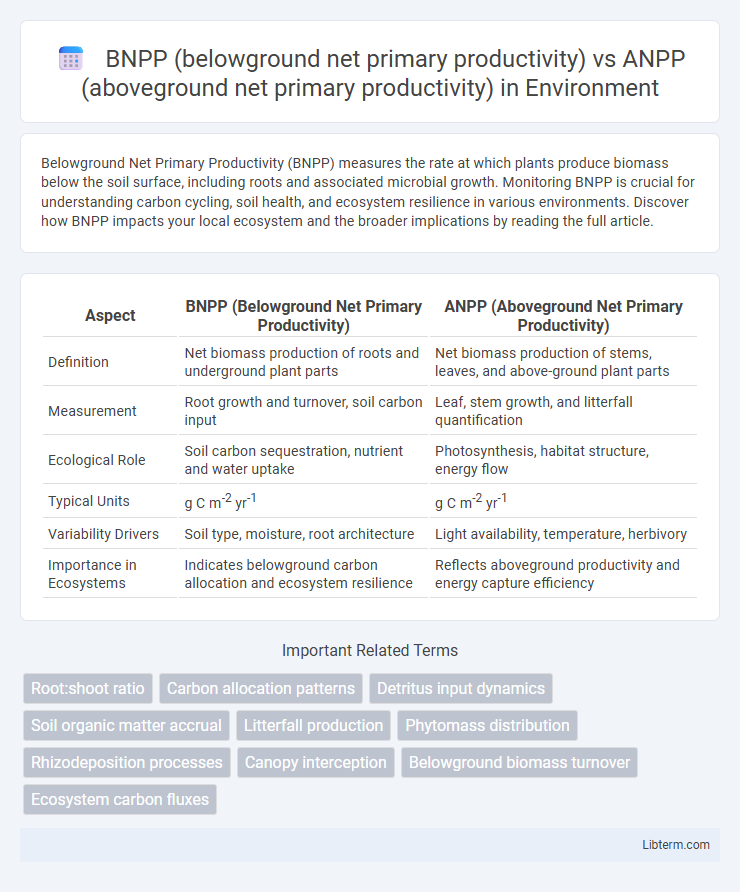Belowground Net Primary Productivity (BNPP) measures the rate at which plants produce biomass below the soil surface, including roots and associated microbial growth. Monitoring BNPP is crucial for understanding carbon cycling, soil health, and ecosystem resilience in various environments. Discover how BNPP impacts your local ecosystem and the broader implications by reading the full article.
Table of Comparison
| Aspect | BNPP (Belowground Net Primary Productivity) | ANPP (Aboveground Net Primary Productivity) |
|---|---|---|
| Definition | Net biomass production of roots and underground plant parts | Net biomass production of stems, leaves, and above-ground plant parts |
| Measurement | Root growth and turnover, soil carbon input | Leaf, stem growth, and litterfall quantification |
| Ecological Role | Soil carbon sequestration, nutrient and water uptake | Photosynthesis, habitat structure, energy flow |
| Typical Units | g C m-2 yr-1 | g C m-2 yr-1 |
| Variability Drivers | Soil type, moisture, root architecture | Light availability, temperature, herbivory |
| Importance in Ecosystems | Indicates belowground carbon allocation and ecosystem resilience | Reflects aboveground productivity and energy capture efficiency |
Introduction to Net Primary Productivity (NPP)
Net Primary Productivity (NPP) measures the net carbon uptake by plants after accounting for respiration, serving as a key indicator of ecosystem productivity. BNPP (Belowground Net Primary Productivity) quantifies root and rhizome biomass growth, crucial for soil carbon sequestration and nutrient cycling. ANPP (Aboveground Net Primary Productivity) reflects the accumulation of biomass in stems, leaves, and reproductive structures, playing a vital role in carbon fixation and energy flow within terrestrial ecosystems.
Defining ANPP and BNPP: Key Concepts
Aboveground net primary productivity (ANPP) measures the rate at which plants produce biomass above the soil surface, including leaves, stems, and flowers, serving as a crucial indicator of ecosystem health and carbon sequestration. Belowground net primary productivity (BNPP) quantifies the biomass generated below the soil, primarily roots, which significantly influences nutrient cycling, soil structure, and carbon storage. Together, ANPP and BNPP provide comprehensive insight into primary productivity, revealing the allocation of plant growth and energy between above- and belowground components within various ecosystems.
Ecological Importance of ANPP and BNPP
ANPP (aboveground net primary productivity) measures plant biomass production visible above soil, critical for supporting herbivores and maintaining ecosystem food webs. BNPP (belowground net primary productivity) reflects root growth and soil carbon inputs, playing a vital role in nutrient cycling, soil structure stabilization, and long-term carbon sequestration. Together, ANPP and BNPP regulate ecosystem productivity, resilience, and biogeochemical processes essential for ecological balance and climate regulation.
Methods for Measuring ANPP and BNPP
Measuring Aboveground Net Primary Productivity (ANPP) commonly involves harvesting and weighing plant biomass within fixed plots at peak growth stages, coupled with remote sensing techniques such as NDVI to estimate vegetation productivity over larger scales. Belowground Net Primary Productivity (BNPP) is often assessed using root ingrowth cores, minirhizotron imaging, and sequential soil coring to quantify root growth and turnover rates over time. Combining these methods allows for a comprehensive evaluation of carbon allocation between aboveground and belowground plant components in various ecosystems.
Factors Influencing BNPP and ANPP Allocation
Soil moisture availability, nutrient concentration, and root-to-shoot signaling strongly influence BNPP allocation, promoting root growth under limited water or nutrient conditions to optimize resource uptake. ANPP is driven by light availability, temperature, and CO2 levels, where enhanced photosynthetic capacity supports aboveground biomass accumulation and aboveground reproductive structures. Species-specific traits and environmental stressors modulate the trade-offs between BNPP and ANPP, shaping ecosystem productivity and carbon cycling dynamics.
BNPP vs ANPP Across Different Ecosystems
Belowground net primary productivity (BNPP) often exceeds aboveground net primary productivity (ANPP) in forest ecosystems due to significant root biomass allocation for nutrient uptake and carbon storage. In grassland ecosystems, BNPP and ANPP tend to be more balanced, reflecting adaptations to fire regimes and grazing pressures that shape resource allocation between shoots and roots. Wetland ecosystems commonly exhibit higher BNPP relative to ANPP, supporting peat formation and carbon sequestration in anaerobic soils.
Climate Change Impacts on BNPP and ANPP
Climate change influences BNPP and ANPP through altered temperature, precipitation patterns, and carbon dioxide levels, reshaping plant growth dynamics and ecosystem carbon balance. Elevated CO2 often enhances ANPP by stimulating photosynthesis, but BNPP responses vary due to soil moisture changes and nutrient availability shifts under warming conditions. Disproportionate impacts on BNPP versus ANPP affect soil carbon sequestration potential and ecosystem resilience, highlighting complex feedbacks in terrestrial carbon cycling under climate change scenarios.
BNPP and ANPP in Carbon Cycling and Sequestration
BNPP and ANPP are critical components of carbon cycling, with BNPP representing root biomass production that contributes to soil organic carbon storage and long-term carbon sequestration. ANPP reflects aboveground biomass growth, influencing carbon uptake through photosynthesis and immediate carbon flux to the atmosphere via litterfall and respiration. Together, BNPP and ANPP regulate ecosystem carbon balance by partitioning carbon input between stable soil pools and dynamic aboveground biomass.
Management Implications for Land Use and Agriculture
BNPP (belowground net primary productivity) and ANPP (aboveground net primary productivity) provide critical insights for land use and agricultural management by influencing soil health, carbon sequestration, and crop yield optimization. Land management practices that enhance BNPP contribute to improved root biomass, soil structure, and nutrient cycling, promoting resilience to drought and erosion. Strategies focusing on balancing BNPP and ANPP enable sustainable agriculture by maximizing productivity aboveground while maintaining belowground ecosystem functions essential for long-term soil fertility.
Future Research Directions in BNPP and ANPP Studies
Future research on BNPP and ANPP should emphasize integrating high-resolution remote sensing and advanced soil carbon modeling to quantify belowground biomass dynamics alongside aboveground productivity. Investigations into the effects of climate change on root turnover and shoot phenology can refine predictive ecosystem models and improve carbon sequestration estimates. Developing standardized methodologies for BNPP measurement will enhance cross-ecosystem comparability and elucidate the coupling between belowground and aboveground processes.
BNPP (belowground net primary productivity) Infographic

 libterm.com
libterm.com